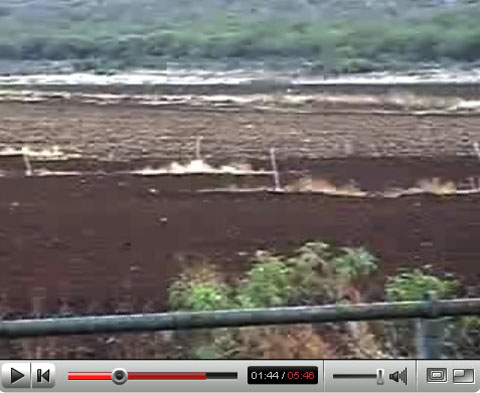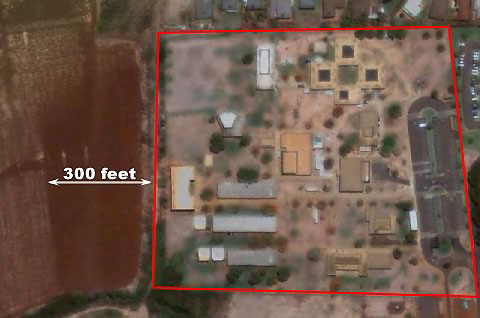by Amanda C. Gregg on 7 February in The Garden Island News
The Hawai’i State Teachers Association (HSTA) agreed yesterday, to dissolve a temporary restraining order (TRO) preventing Syngenta Seeds from spraying pesticides in a field adjacent to Waimea Canyon Middle School (WCMS).
The HSTA had threatened to ask for a 30-day injunction preventing Syngenta from spraying, after 60 students went home ill and 10 were taken to the hospital via ambulance January 25.Neither the Department of Health nor the Department of Agriculture responded to administrators’ requests to come to the school and take swab tests following the incident.
Tom Perry, Kaua‘i director for the Hawaii State Teachers Association, said over the past two years there have been spikes in the number of students that go home ill in conjunction with pesticide spraying.
However, neither Perry nor his attorney had evidence to support that information to present in Fifth Judicial Circuit Judge Kathleen Watanabe’s courtroom.
Perry said in a phone interview that he plans to subpoena the records of the school’s health clinic.
The Garden Island obtained one such record through a Freedom of Information Act request stemming from a November 14, 2006 complaint filed by teachers, in which 60 students went to the health room with complaints of nausea, headache, stomach ache, dizziness and vomiting. Thirty four students went home that day, the report states.
Officials had said the most likely culprit of the symptoms were caused by a Westside weed called cleome gynandra, also known as a wild spider flower.
Syngenta plowed under roughly 50 acres of the weed and students returned to school the following week.
A second DOA investigation following a January 23, 2007 complaint that several students and teachers had again fallen ill following spraying found the company appropriately sprayed insecticides on the fields. The fields are located some 800 feet from Waimea Canyon School in Kekaha. The findings of that report — which also required a Freedom of Information Act request — showed the company applied Sevin, a pesticide, according to its labeling instructions.
The HSTA brought Syngenta Seeds to court yesterday following the third complaint filed by teachers following a January 25 spraying. The HTSA filed a motion for a TRO because the company refused to comply with a spraying protocol agreement reached by both sides following the previous complaints, Perry said.
“We asked them to have (a temporary) moratorium for spraying and Syngenta refused,” Perry said.
Two days later, when the company was spraying again, Perry said, “we had no choice but to file a restraining order.”
Anne Burt, a Syngenta spokeswoman, said the company wasn’t aware the HSTA had filed a motion requesting a break from the spraying.
In the agreement hashed out by both sides yesterday, Syngenta agreed to construct a 12-foot-high dust-fence along the vegetated buffer zone separating the field from the school. Syngenta will be allowed to spray one more time, either today or tomorrow, before the fence goes up.
In turn, HSTA agreed to dissolve the temporary restraining order and withdrew their complaint without prejudice.
“We are sorry that it came to a lawsuit for this new wall to happen, we didn’t know that is what they wanted until just today,” Burt said in an e-mail.
“We have been in many meetings and working in close collaboration with the school administration, faculty and union for two years now, and we would have been glad to entertain a request for a new protocol.”
Burt, who arrived on-island Tuesday, also said the company cares about students, especially as some are the children of its employees.
“We are committed to working closely with the community and school administration, and will continue to do so.”
The Department of Education decided not to support a bill introduced Tuesday by Sen. Gary Hooser (D-Kaua‘i) that would have stipulated several requirements when spraying pesticides near schools, including a proposed 1,500-foot buffer.
Perry said the proposed legislation scared off support because it was too limited.
An amended version of the bill, slated to include all K-12 schools, is expected to be heard next week.
Bill Arakaki, complex area superintendent for the Department of Education (DOE), said he expects to be on-island Sunday to determine whether students can safely return to school Monday.
He also plans to meet with the Department of Health (DOH) and Department of Agriculture (DOA), he said.
“We’re just concerned about the safety of students and teachers,” he said. “Until we can gather data, we need to get a baseline of information so can make decisions and work from there.”
Burt said it is out of deep respect for the community that Syngenta is adding another action to its standing protocols that go over and above all laws in the field adjacent to the school.
“Syngenta hopes that the cause of the illness is fully investigated. We do not believe our usage of pesticides, which has complied with all local, state and federal laws and has been regularly inspected by the DOA and found fully safe, is the cause.”
Should anyone complain again about the same symptoms in conjunction with future sprayings, Perry said, the HSTA will be back in court.
|



